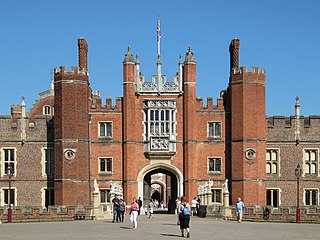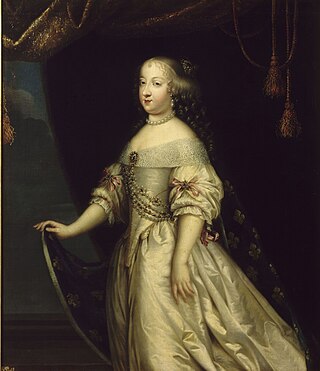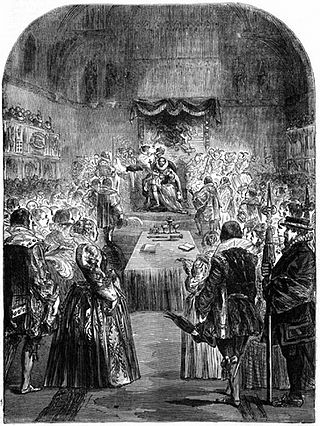Related Research Articles

Louis XIV, also known as Louis the Great or the Sun King, was King of France from 1643 until his death in 1715. His verified reign of 72 years and 110 days is the longest of any sovereign. An emblematic character of the Age of Absolutism in Europe, Louis XIV's legacy is widely characterized by French colonial expansion, the conclusion of Eighty Years' War involving the Habsburgs, and his architectural bequest, marked by commissioned works of art and buildings. His pageantry, opulent lifestyle and ornate cultivated image earned him enduring admiration. Louis XIV raised France to be the exemplar nation-state of the early modern period, and established a cultural prestige which lasted through the subsequent centuries, and continues today.

Hampton Court Palace is a Grade I listed royal palace in the London Borough of Richmond upon Thames, 12 miles southwest and upstream of central London on the River Thames. Opened to the public, the palace is managed by Historic Royal Palaces, a charity set up to preserve several unoccupied royal properties.

MonsieurPhilippe I, Duke of Orléans was the younger son of King Louis XIII of France and Anne of Austria, and the younger brother of King Louis XIV. He was the founder of the House of Orléans, a cadet branch of the ruling House of Bourbon.

Maria Theresa of Spain was Queen of France from 1660 to 1683 as the wife of King Louis XIV. She was born an Infanta of Spain and Portugal as the daughter of King Philip IV and Elisabeth of France, and was also an Archduchess of Austria as a member of the Spanish branch of the House of Habsburg.

A kaftan or caftan is a variant of the robe or tunic. Originating in Asia, it has been worn by a number of cultures around the world for thousands of years. In Russian usage, kaftan instead refers to a style of men's long suit with tight sleeves.

Gloriana, Op. 53, is an opera in three acts by Benjamin Britten to an English libretto by William Plomer, based on Lytton Strachey's 1928 Elizabeth and Essex: A Tragic History. The first performance was presented at the Royal Opera House, London, in 1953 during the celebrations of the coronation of Queen Elizabeth II. Gloriana was the name given by the 16th-century poet Edmund Spenser to his character representing Queen Elizabeth I in his poem The Faerie Queene. It became the popular name given to Elizabeth I.

Antoine, 1st comte de Noailles became admiral of France, and was ambassador in England for three years, 1553–1556, maintaining a gallant but unsuccessful rivalry with the Spanish ambassador, Simon Renard.

The Kingdom of France is the historiographical name or umbrella term given to various political entities of France in the medieval and early modern period. It was one of the most powerful states in Europe from the High Middle Ages to 1848 during its dissolution. It was also an early colonial power, with colonies in Asia and Africa, and the largest being New France in North America centred around the Great Lakes.

A justacorps or justaucorps is a knee-length coat worn by men in the latter half of the 17th century and throughout the 18th century. It is of French origin, where it had developed from a cape-like garment called a casaque. It was introduced into England as a component of a three-piece ensemble, which also included breeches and a long vest or waistcoat. This ensemble served as the prototype for the modern-day three-piece suit. The justacorps itself evolved into the frock coat.

The ceremonies and festivities accompanying a formal entry by a ruler or their representative into a city in the Middle Ages and early modern period in Europe were known as the royal entry, triumphal entry, or Joyous Entry. The entry centred on a procession carrying the entering ruler into the city, where they were greeted and paid appropriate homage by the civic authorities, followed by a feast and other celebrations.

The portraiture of Queen Elizabeth I (1533–1603) spans the evolution of English royal portraits in the early modern period (1400/1500-1800), from the earliest representations of simple likenesses to the later complex imagery used to convey the power and aspirations of the state, as well as of the monarch at its head.
Philip Robert Rhys Mansel is a British historian of courts and cities, and the author of a number of books about the history of France and the Ottoman Empire. He was born in London in 1951 and educated at Eton College, Balliol College, Oxford, and obtained a doctorate at University College London in 1978. He has lived in Paris, Istanbul and Beirut and now lives in London.

A royal bastard is a child of a reigning monarch born out of wedlock. The king might have a child with a mistress, or the legitimacy of a marriage might be questioned for reasons concerning succession.

Symbolism in the French Revolution was the use of artistic symbols to emphasize and celebrate the main features of the French Revolution and promote public identification with and support for the cause. In order to effectively illustrate the differences between the new Republic and the old regime, revolutionaries implemented new symbols to be celebrated instead of the old religious and monarchical symbolism.

Maddox Street is a street in the Mayfair area of London, extending from Regent Street to St George's, Hanover Square.

The coronation of James I and his wife Anne as king and queen of England and Ireland was held on 25 July 1603 at Westminster Abbey. James had reigned as king of Scotland since 1567. Anne was anointed and consecrated with prayers alluding to Esther, the Wise Virgins, and other Biblical heroines. It was the first coronation to be conducted in English instead of Latin. Because of the 1603 London plague, a planned ceremonial Royal Entry to London was deferred until 15 March 1604.

Mary I of England (1516–1558) and Philip of Spain married at Winchester Cathedral on Wednesday 25 July 1554.

Charles X Distributing Awards to Artists is an 1827 painting by the French artist François Joseph Heim. It depicts the French monarch Charles X awarding legion of honours to artists who exhibited at the Paris Salon of 1824 at a ceremony held on 15 January 1825. The King who had succeeded his brother Louis XVIII in 1824 is shown in the uniform of the National Guard. It features portraits of many of the leading artists of the era. The royal official Ambroise-Polycarpe de La Rochefoucauld and the director of the Louvre Louis Nicolas Philippe Auguste de Forbin are shown close to the king. Heim became a celebrated depicter of scenes of the Bourbon Restoration. It is now in the collection of the Louvre and is displayed in the Salon Carré.

At the beginning of his career, Napoleon was a soldier and wore the uniform of the French Revolutionary Army. In 1793 he was promoted to Général de brigade, in 1795 Général de division, and in 1796 he became commander in chief of the Army of Italy. In those capacities, he wore the uniform of a French Army general as promolgated by the regulations of January 1796. This was, a double breasted blue (woollen) coat with red collar, red cuffs with white flaps, gold oak-leaf embroidery on the collar, cuffs, pickets and fron tand rear openings, and a red and white sash with gold trim. There does not seem at this point to be any differentiation between grades of general. Napoleon wore this in Italy, Egypt, and at the Battle of Marengo in 1800.

The Salon of 1824 was an art exhibition held at the Louvre in Paris between 25 August 1824 and 15 January 1825. It took place during the Restoration Era that followed the downfall of Napoleon's French Empire. At the time one of Europe's premier art exhibitions, the Salon was held roughly biennaly during the period. It was the first to be held since Charles X succeeded to the throne earlier the same year.
References
- Riley, Philip F. (2007). "Dressed to Rule: Royal and Court Costume from Louis XIV to Elizabeth II. By Philip Mansel. (New Haven, Conn.: Yale University Press, 2005. Pp. xii, 237. $35.00.)". The Historian . 69 (3): 587–588. doi:10.1111/j.1540-6563.2007.00189_57.x. S2CID 144732894. - Published online on 10 January 2020
Notes
- 1 2 Strong, Roy (2005-08-06). "The Emperor's real clothes". The Spectator . Retrieved 2020-04-11.
- 1 2 Riley, p. 587.
- 1 2 "Dressed to Rule: Royal and Court Costume from Louis XIV to Elizabeth II". Publishers Weekly . 2005-05-30. Retrieved 2020-04-11.
- 1 2 Riley, p. 588.